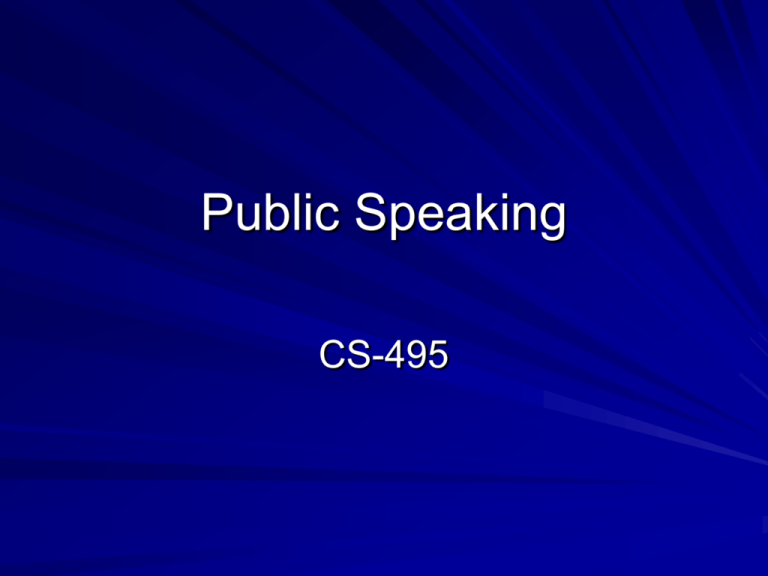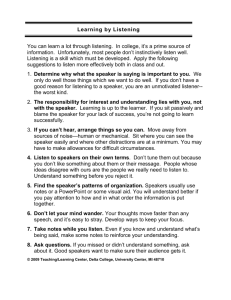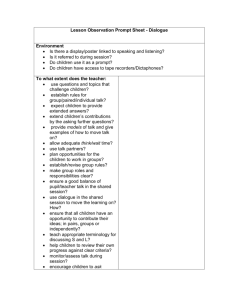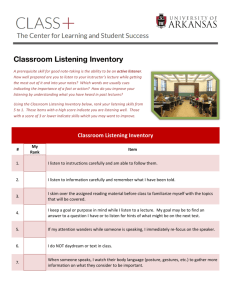PublicSpeaking - dforeman.cs.bingh
advertisement

Public Speaking CS-495 Public Speaking (PS) “Talk is cheap” – No! A well organized, thoughtful talk is: Profitable Informative Speaking Opportunities At work – Sell your ideas – Technical presentations – Customer Presentations and Reviews Daily Life – School & Town Board Meetings – PTA Meetings – Scout Meetings Similarities between PS and Conversation Organize your thoughts – Giving someone directions to your house Tailor your message to the audience Telling a story for maximum impact – Don’t tell the “punch line” of a story first Adapting to listener feedback – Watch for non-verbal feedback – looks of confusion, looks of pain or hurtfulness Differences between PS and Conversation PS is more structured – Usually time limited – Questions not allowed to interrupt the speech, usually left for the end (time permitting) PS requires more formal language – No slang, jargon or bad grammar – Speeches should be something special so that they qualify as life events and are remembered PS requires a different method for delivery The Speech Communication Process Speaker – one who delivers the information Message – the information Channel – means by which a message is communicated Listener – the receiver of the communicated message Feedback – comes in many forms and must be understood Interference - anything impeding communication of the message Situation – time and place of occurrence Listening Listening is important – We will listen to more speeches than we will deliver – Helps develop critical thinking – Many Fortune 500 companies provide employees with listening training – Studies show a direct link between academic success and the ability to listen – Listening and hearing are two different things Listening and Critical Thinking There are four types of listening: – Appreciative Listening for pleasure or enjoyment – Music, movies, comedy, plays… – Empathetic Listening to provide emotional support for speaker – A shrink listens to a patient; you listen to a friend’s rant – Comprehensive Listening to understand the speakers message – Direction to a friend’s house; in a class or seminar – Critical Listening to evaluate a message – A campaign speech; a peer’s research paper Critical Thinking – Comprehensive and Critical require you to think and evaluate while listening, this helps develop Critical Thinking skills Causes of Poor Listening Not Concentrating – Daydreaming, mind wandering, dozing Listening Too Hard – Trying to remember every fact, no matter how minute Jumping To Conclusions – Putting words into the speakers mouth; interrupting speaker, anticipating what speaker will say/do next Focusing On Delivery Instead Of Message – Speakers accent, clothes, stuttering, presentation tools Better Listening Take Listening Seriously – Like any skill it takes practice and self-descipline Resist Distractions – When you catch your mind wandering make a conscious effort to pull it back on track; try to anticipate what the speaker will say/do next Don’t be Diverted by Appearance or Delivery – Lincoln and Gandhi were strange in appearance but were excellent speakers Suspend Judgment – “a closed mind is an empty mind” Focus Your Listening – Listen for main points A good speech only has a few – Listen for evidence Is it accurate Are the sources objective Is it relevant Is it sufficient to support the speakers claim – Listen for technique Study the speakers technique as a learning tool Analyzing the Audience Good speakers are audience-centered – Primary purpose of a speech is to get a desired response Keep the audience foremost in mind at every step of preparation and presentation – To whom are you speaking? – What is it you want them to know, believe or do as a result? – What is the most effective way to compose and present your speech to accomplish those ends? The Psychology of Audiences It’s up to the speaker to make the audience choose to pay attention. Every speech contains two messages: – One from the speaker – One received by the listener – “People hear what they want to hear and disregard the rest.” – Paul Simon’s The Boxer People are egocentric – Egocentrism – the tendency for people to be most interested in themselves, their own problems and the way to solve them. – They pay closest attention to what affects their own values, beliefs and well being. Demographic Audience Analysis Look for observable audience traits – Identify the general features – Gauge their importance to the situation Traits – Age Whatever your age, you’re a product of your world – Gender Old stereotypes no longer apply Avoid sexist language and references – Racial, Ethnic or Cultural Background Be aware of differences and be able to adapt – Religion Highly charged emotional issue, be sure to consider the religious orientation or you might end up being embarassed. – Group Membership Guilt by association – people judge you by the company you keep Situational Audience Analysis Builds on demographic analysis ; identifies traits unique to the speaking situation – Size – Physical Setting – Disposition toward the Topic Interest Knowledge Attitude – Disposition toward the Speaker – Disposition towards the Occasion Adapting to the Audience Before the Speech – Assess how the audience is likely to respond – Adjust what you say to make it Clear Appropriate Convincing During the Speech – Things may/will not go exactly as you plan – Don’t panic, remain calm and adapt – Remember: Who am I speaking to? What do I want them to know, believe or do? What is the best way to accomplish this? Practice, practice, practice Organizing a Speech – Main Points Main Points – Number of main points It is better to be remembered for covering 3 or 4 points well than to leave the audience confused and sorting out 7 or 8 points you made. – Strategic Order of Main Points Chronological Order Spatial Order Casual Order Problem Solution Order Topical Order Main Points (cont.) Each main poin should be independent of the other main points. Use the same pattern of wording for each main point Balance the amount of time spent on each main point. Organizing a Speech – Supporting Materials Supporting Materials – – – – The “flesh” that fills out the skeleton of your speech By themselves main points are only assertions. Listeners need supporting materials to accept what the speaker says Three major types of supporting materials: Examples Statistics Testimony – Always provide sources to give credibility to the supporting materials Organizing a Speech Connectives – Transitions Words or phrases that indicate speaker has finished one thought and is moving to another: – “In addition” , “also” , “Not only” , “That brings me to the next topic” – Internal Previews Lets the audience know what the speaker will take up next – “now that we realize the seriousness, I will address three solutions” – Internal Summaries Remind the audience of what they have just heard – “Let me reiterate…” – Signposts Brief statements that let you know where you are in the speech – Numerate – “First this…, second this …” – Introduce a main point with a question – “What make this so…” – Simple phrase – “The most important thing to remember…”







